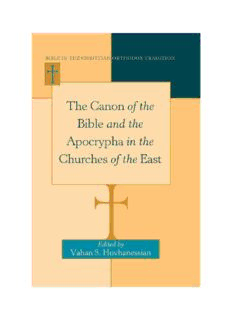
The Canon of the Bible and the Apocrypha in the Churches of the East PDF
Preview The Canon of the Bible and the Apocrypha in the Churches of the East
The Canon of the Bible and the Apocrypha in the Churches of the East @ BIBLE IN THE CHRISTIAN ORTHODOX TRADITION Vahan S. Hovhanessian General Editor Vol. 2 PETER LANG New York (cid:121) Washington, D.C./Baltimore (cid:121) Bern Frankfurt am Main (cid:121) Berlin (cid:121) Brussels (cid:121) Vienna (cid:121) Oxford The Canon of the Bible and the Apocrypha in the Churches of the East Edited by Vahan S. Hovhanessian PETER LANG New York (cid:121) Washington, D.C./Baltimore (cid:121) Bern Frankfurt am Main (cid:121) Berlin (cid:121) Brussels (cid:121) Vienna (cid:121) Oxford Library of Congress Cataloging-in-Publication Data The canon of the Bible and the Apocrypha in the churches of the east / [edited by] Vahan S. Hovhanessian. p. cm. — (Bible in the Christian Orthodox tradition; v. 2) Includes bibliographical references (p. ) and index. 1. Bible—Canon. 2. Apocryphal books. 3. Orthodox Eastern Church—Doctrines. I. Hovhanessian, Vahan. BS465.C37 220.1’20882815—dc23 2011044701 ISBN 978-1-4331-1035-1 (hardcover) ISBN 978-1-4539-0529-6 (e-book) ISSN 1947-5977 Bibliographic information published by Die Deutsche Nationalbibliothek. Die Deutsche Nationalbibliothek lists this publication in the “Deutsche Nationalbibliografie”; detailed bibliographic data is available on the Internet at http://dnb.d-nb.de/. The paper in this book meets the guidelines for permanence and durability of the Committee on Production Guidelines for Book Longevity of the Council of Library Resources. © 2012 Peter Lang Publishing, Inc., New York 29 Broadway, 18th floor, New York, NY 10006 www.peterlang.com All rights reserved. Reprint or reproduction, even partially, in all forms such as microfilm, xerography, microfiche, microcard, and offset strictly prohibited. Printed in Germany Contents Preface ............................................................................................... vii The Canon of Scripture in the Orthodox Church ................................... 1 Eugenia Scarvelis Constantinou The Prayer of Manasses: Orthodox Tradition and Modern Studies in Dialogue ......................................................................................... 7 Daniel Alberto Ayuch Testament of Solomon and Other Pseudepigraphical Material in Aḥkām Sulaymān (Judgment of Solomon) ...................................... 21 Slavomír Čéplö (bulbul) The Book of Wisdom of Solomon in the Armenian Church Literature and Liturgy ....................................................................................... 39 Anushavan Tanielian Visul Maicii Domnului (“The Dream of the Mother of the Lord”): New Testament Romanian Amulet Text .......................................... 43 Nicolae Roddy Banned from the Lectionary: Excluding the Apocalypse of John from the Orthodox New Testament Canon ..................................... 51 Eugenia Scarvelis Constantinou vi •CONTENTS• New Testament Apocrypha and the Armenian Version of the Bible ....................................................................................... 63 Vahan S. Hovhanessian Notes .................................................................................................... 89 Bibliography ...................................................................................... 107 Index .................................................................................................. 111 Preface T his is the third volume to be published by the “Bible in the Eastern and Oriental Orthodox Traditions” unit of the Society of Biblical Literature (SBL). The first volume was published in 2009 under the title Exegesis and Hermeneutics in the Churches of the East, which included the papers presented and discussed at the SBL meeting in San Diego, USA. The second volume, The Old Testament as Authoritative Scripture in the Early Churches of the East, was published in 2010 as the first volume in the new series “Bible in the Christian Orthodox Tradition.” The papers published in this book represent the latest scholarly findings in the field of Apocrypha and the New Testament canon from the perspective of the churches of the East. These findings were presented and discussed at the July 2009 International Meeting of SBL in Rome, Italy, and at the November 2009 Annual Meeting of SBL in New Orleans. These two sessions became two giant steps in strengthening the foundation laid years ago through the establishment of the SBL unit as a forum for a new scholarly endeavor to explore a critical examination of biblical scholarship as founded and developed in the earlier centuries of Christianity within the Orthodox churches in the East. Sincere thanks to the steering committee members of the “Bible in the Eastern and Oriental Orthodox Traditions” unit of the SBL, and to the scholars who chaired and moderated the sessions as well as those who presented the fruits of their scholarly labor as part of the unit’s program. May the Lord continue blessing us as we strive to explore, understand and teach His word. Bishop Vahan Hovhanessian, Ph.D. November 2011 • E U G E N I A S C A R V E L I S C O N S T A N T I N O U • The Canon of Scripture in the Orthodox Church T he precise status, content and role of the canon in the Orthodox Church escape easy definitions and explanations. The Eastern Church never conclusively defined a canon of Scripture in an authoritative statement such as those ultimately pronounced in the West. Although the Orthodox Church is one Church, united in one faith and historically connected to the early apostolic Church, it is also simultaneously many separate, autonomously functioning churches. The various Orthodox churches embrace a variety of practices and traditions with respect to liturgics, iconography, lectionary and even the canon of Scripture itself. Among the Orthodox Churches are both Chalcedonian (“Eastern Orthodox”) and non-Chalcedonian (“Oriental Orthodox”). The most unusual aspect of the canon of Scripture among the Orthodox is that no official canon exists at all and the canon remains somewhat loose. The word “canon” (kanon in Greek) originally meant a reed or measuring stick. It came to mean the applicable standard for measurement: a ruler. The word “canon” was employed to refer to a rule or Church law. With respect to the Bible, “canon” is the list of books recognized as authoritative Scripture because when deciding which books should be considered Scripture, the Church applied certain standards. The canon of Scripture also demarcates those books which may be read in Church. The Septuagint Some consider the consistent use of the Septuagint to be the most distinctive characteristic of the Orthodox canon. The Septuagint was
Description: